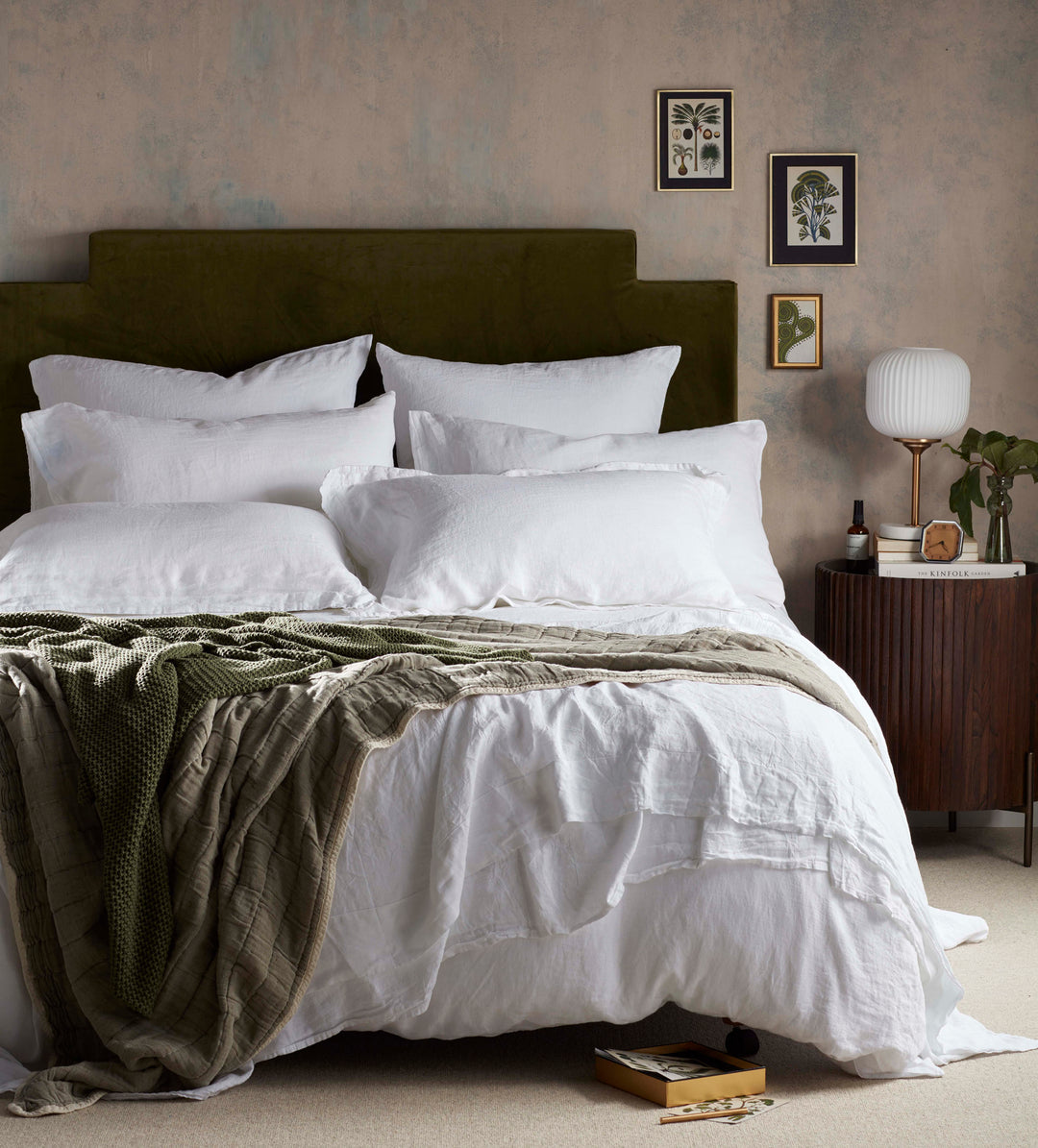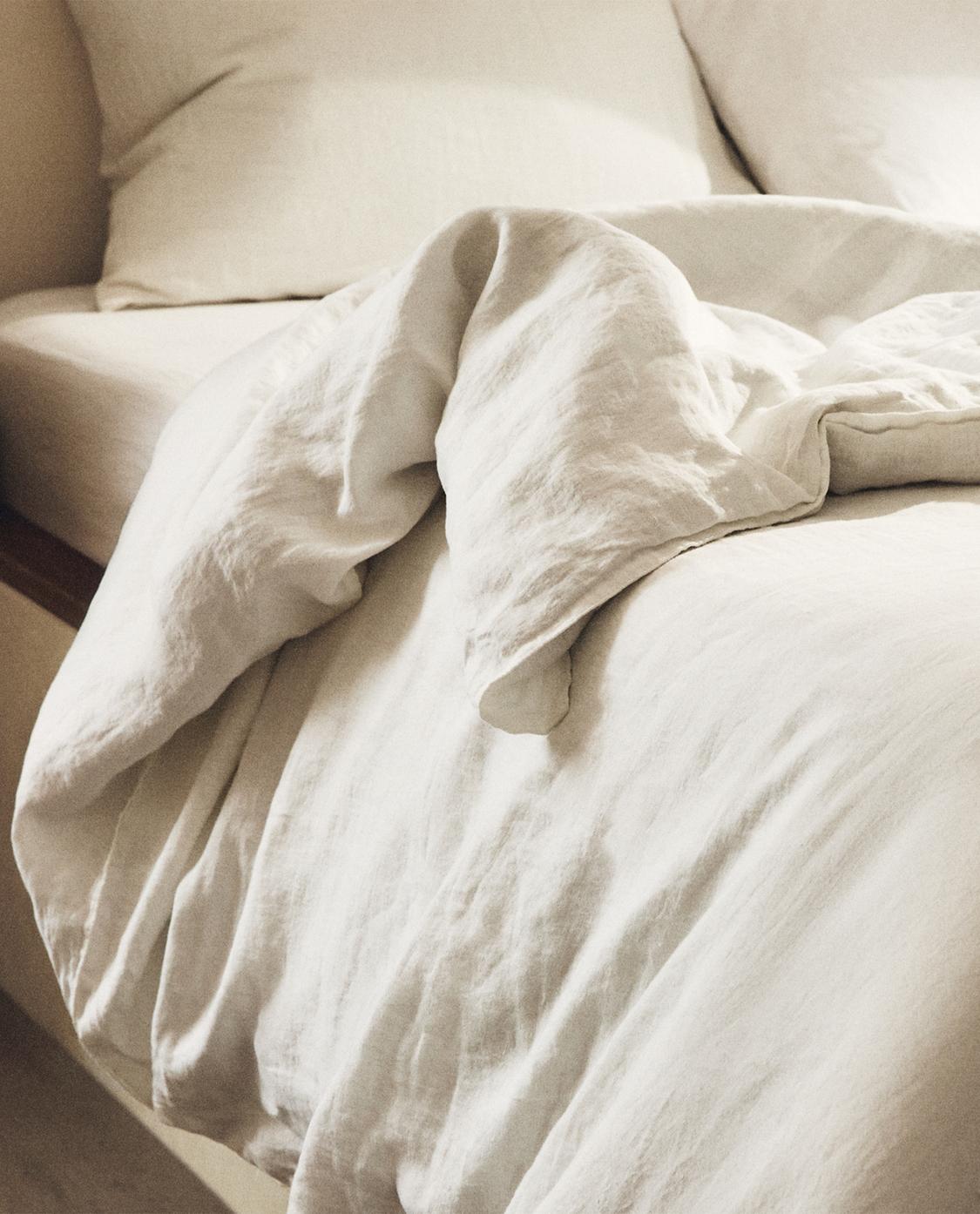Understanding Linen: The Eco-Friendly Alternative for Comfy Living
When you consider environment-friendly textiles, bed linen typically stands out for its unique qualities. This natural textile, made from the flax plant, offers both comfort and sustainability. Its impressive residential or commercial properties make it a perfect option for warm weather condition and durable usage. What really sets linen apart from other materials? Understanding its benefits and origins can transform how you see home fabrics. Let's discover the remarkable globe of linen further.
The Origins of Linen: From Flax to Fabric

Bed linen, one of the earliest fabrics understood to humankind, has a remarkable journey that begins with the simple flax plant. Once collected, the flax stalks undergo a procedure called retting, where they're saturated to separate the fibers from the woody parts.
When you see bed linen textile, you're observing centuries of craftsmanship. The weaving procedure transforms those spindles of string right into the lovely, resilient cloth you love. Bed linen has actually been cherished for its natural look, making it a favorite for whatever from apparel to home fabrics. Next time you touch bed linen, remember its abundant background that connects you to ancient societies and their traditional methods.
The Special Properties of Bed Linen
One of the standout functions of this amazing textile is its breathability. When you put on bed linen, you'll see just how it permits air to flow, maintaining you cool down on warm days. This home makes it an excellent selection for summer apparel and sheets.
Bed linen likewise flaunts exceptional moisture-wicking capacities, pulling sweat away from your skin and allowing it to evaporate promptly. You won't feel clammy, also in moist conditions. In addition, bed linen is long lasting, typically ending up being softer and a lot more comfy with each laundry, which indicates it can stand the examination of time in your closet.
An additional distinct element is its all-natural structure; the minor irregularities offer bed linen a character that boosts your style. Plus, it withstands wrinkles far better than numerous various other materials, so you can enjoy a relaxed yet brightened look without much initiative. Welcome linen, and you'll value its comfort and distinct beauty.
Environmental Benefits of Bed Linen
When you select bed linen, you're not simply choosing for a stunning material; you're likewise supporting sustainable manufacturing methods. Bed linen's naturally degradable and compostable nature makes it a smart option for the setting. Plus, it requires considerably much less water to create compared to various other fabrics, helping preserve this valuable source.
Lasting Production Practices
Although numerous materials have substantial ecological effects, linen attracts attention because of its lasting production techniques. When you choose bed linen, you're selecting a material made from the flax plant, which requires minimal water and chemicals. This resilient crop can flourish in poor dirt conditions, decreasing the need for chemical plant foods. In addition, the entire flax plant is used in manufacturing, decreasing waste and advertising resource efficiency.
Bed linen production is typically less energy-intensive contrasted to other fabrics, as it includes all-natural processes instead than synthetic treatments. By sustaining linen, you're adding to a much more lasting textile market that prioritizes eco-friendly methods. Selecting bed linen not only enhances your comfort but additionally aligns your values with environmental duty.
Biodegradable and Compostable Material
Linen's green nature extends beyond its lasting production; it's likewise naturally degradable and compostable, making it a superb option for ecologically aware customers. When you select bed linen products, you're selecting materials that break down naturally, returning nutrients to the earth. This indicates that at the end of their life process, your linen items won't add to garbage dump waste. Instead, they can disintegrate securely, reducing your ecological footprint. Moreover, composting bed linen can improve dirt, advertising healthy plant growth. By integrating bed linen right into your home, you're not simply appreciating its comfort and resilience; you're likewise helping and supporting eco-friendly practices produce a healthier planet. Embrace linen, and really feel good regarding your choices for the atmosphere.
Low Tide Consumption
Among the standout advantages of linen is its low tide usage during farming. Unlike cotton, which needs substantial watering, linen's flax plant thrives on very little water, making it a much more lasting choice. You'll value understanding that for every load of bed linen created, significantly much less water is needed contrasted to numerous various other textiles. This indicates that picking linen aids preserve crucial freshwater resources, which is important in today's environment. Additionally, linen's all-natural drought resistance enables it to expand in less-than-ideal problems, even more minimizing its environmental effect. By choosing linen, you're not just investing in high quality; you're likewise sustaining a textile that advertises liable water usage and adds to a healthier planet for future generations.
Linen vs. Various Other Fabrics: A Comparison
When you contrast bed linen to various other textiles, you'll notice its remarkable breathability and convenience, making it perfect for cozy climate. And also, linen sticks out for its longevity and longevity, typically lasting longer than numerous commonly used products. As you consider your options, the ecological influence of each textile will likewise play an important function in your decision.
Breathability and Comfort
Bed linen stands out among materials for its amazing ability to permit air flow. Unlike synthetic materials, which can trap heat and moisture, bed linen's all-natural fibers wick away sweat, maintaining you great and completely dry.
Cotton is typically praised for its softness, yet it does not match linen's breathability. Even blends could not supply the very same ventilation. If you prioritize convenience, particularly in summertime, linen should be your best option. It not only maintains you feeling fresh yet likewise brings an ageless elegance to your closet.
Longevity and Long Life
While numerous fabrics use varying levels of sturdiness, linen genuinely excels in long life, making it a smart financial investment for your closet. Unlike cotton or synthetic products that might break quickly, bed linen gets more powerful with each wash. Its all-natural fibers resist fading and fraying, address ensuring your garments look excellent in time. You'll locate that linen's breathable nature additionally decreases wear from sweat and dampness, which can damage other textiles. Plus, its capacity to withstand heats means it won't reduce easily in the clothes dryer. When you pick linen, you're choosing a resilient fabric that can deal with day-to-day usage while keeping its charm. Believe me, your long-term investment in linen will certainly repay with years of stylish, comfy wear.
Environmental Influence Contrast
Although many fabrics contribute to environmental issues, bed linen stands out for its green high qualities. Unlike cotton, which requires massive water resources and pesticides, bed linen is made from flax, a plant that thrives on very little water and needs less chemicals. This means you can feel good concerning your selection while minimizing your carbon footprint.
When contrasted to synthetic fabrics like polyester, linen's biodegradability shines. While polyester can take hundreds of years to decay, linen breaks down naturally, returning nutrients to the dirt.
Selecting linen not just advertises lasting farming methods however additionally sustains a much healthier world. By going with bed linen over standard materials, you're making a conscious choice that profits both your comfort and the atmosphere.
Taking care of Your Linen Textiles
To guarantee your linen fabrics continue to be in great problem, you'll desire to adhere to some uncomplicated care standards. First, clean your linen in cool water on a mild cycle to avoid it from shrinking or shedding its shape. Avoid making use of bleach, as it can harm the fibers. Rather, choose a light detergent that's cost-free from article source severe chemicals.
When it pertains to drying out, air drying is ideal. If you use a clothes dryer, choose a reduced warmth setup and eliminate the items while they're still a little damp to decrease creases. Iron the linen while it's still damp for easier handling, or vapor it to keep it looking crisp.
For storage space, keep your linen in a trendy, dry location. Stay clear of direct sunlight to avoid fading. With these straightforward practices, your bed linen fabrics will preserve their elegance and last for years, making them a sustainable addition to your lifestyle.
Including Linen Into Your Home Decoration
Taking care of your bed linen fabrics not only maintains their top quality yet also opens up a world of possibilities for incorporating them into your home decoration. You can begin small by including bed linen throw pillows to your sofa, instantaneously boosting the space with structure and heat. Take into consideration linen curtains that filter sunlight wonderfully, producing a soft, ventilated ambience in any kind of room.
For an extra rustic appearance, attempt utilizing linen tablecloths or runners during meals; they add a stylish touch and are easy to clean. If you're feeling daring, mix and match different bed linen shades and patterns to develop a distinct, layered impact.
Don't ignore bed linen coverings-- curtain one over a chair or your bed for a welcoming feeling. By attentively incorporating bed linen into your decoration, you improve both convenience and design, making your home a calm hideaway.
The Future of Bed Linen in Sustainable Living
As consumers increasingly prioritize sustainability, bed linen arises as a frontrunner in green fabrics. Its production makes use of much less water and chemicals contrasted to standard cotton, making it an extra eco responsible choice. As you look towards a lasting future, incorporating bed linen right into your wardrobe and home can substantially reduce your carbon impact.
Ingenious brands are now concentrating on sustainable techniques, from utilizing organic flax to implementing round economic climate concepts. You'll locate that linen's toughness means it lasts longer, decreasing the requirement for regular replacements.
Moreover, as even more individuals welcome minimal way of livings, bed linen's ageless allure and versatility will keep it appropriate. By choosing bed linen, you're not simply selecting convenience; you're likewise supporting sustainable methods.
In the upcoming years, the demand for linen is expected to expand, strengthening its area in a much more eco-conscious world. Consider making bed linen a staple in your sustainable living trip.
Regularly Asked Concerns
Is Linen Appropriate for Individuals With Allergic Reactions?
Yes, linen's all-natural fibers are hypoallergenic, making it suitable for people with allergies. Its breathable nature helps in reducing dampness and germs accumulation, adding to a healthier resting setting. You'll likely find it comfy and secure.
Can Linen Be Colored Conveniently?
Yes, you can color linen easily. Its all-natural fibers soak up dyes well, allowing for lively shades. Just make sure you make use of the best color kind and comply with correct techniques to attain the wanted results without harming the fabric.
Exactly How Does Bed Linen Compare in Durability to Cotton?

What Weight of Linen Is Ideal for Summertime Clothes?
For summer season apparel, lightweight bed linen around 4 to 5 ounces per yard is excellent. It maintains you awesome, breathable, and comfy in warm weather (Linenshed). You'll value exactly how it drapes and moves with you effortlessly

Can Linen Be Utilized for Outdoor Furniture?
Yes, you can use linen for exterior furniture. It's breathable and long lasting, making it a great choice for warm weather condition. Simply make sure to select a treated version to endure the components and maintain its appearance.
Conclusion
Integrating linen into your life not only boosts your comfort but likewise sustains a more sustainable future. By choosing this environmentally friendly material, you're making a mindful decision that benefits both your well-being and the earth. With its distinct homes and minimal environmental influence, linen is a clever option for your home decoration and way of living. Welcome bed linen, and enjoy the perfect mix of design, resilience, and sustainability in your daily living.
Bed linen's eco-friendly and compostable nature makes it a clever selection for the setting. By integrating linen into your home, you're not just appreciating its convenience and sturdiness; you're additionally supporting environmentally friendly practices and aiding develop a healthier planet. The Future of Bed Linen in Lasting Living.
